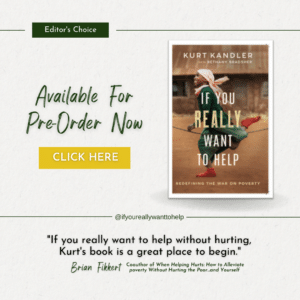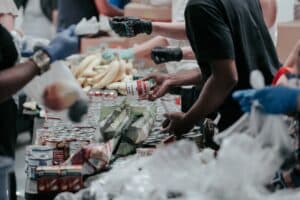Check out my previous blog for some context… This is part two.
Helping Hand
As the HUD Secretary, the context of Carson’s position focused on the government’s role in domestic poverty. He said that he believes that government can provide a “helping hand” to people looking to climb out of poverty. But he warned against programs that are “sustaining them in a position of poverty. That’s not helpful”, he claims.
I agree, of course. That’s probably not a surprise to anyone who’s spent more than ten minutes talking to me about 410 Bridge’s development model. The government should help.
Safety nets are needed, helpful, and a good thing. But it shouldn’t create programs that keep people from thriving on their own. It shouldn’t create systems that promote passivity and disempower people.
 Carson’s comments got me thinking and was another reason I wrote my book – If You Really want to Help.
Carson’s comments got me thinking and was another reason I wrote my book – If You Really want to Help.
Shouldn’t non-profits be held to the same standard? Shouldn’t non-profits, especially faith-based organizations, resist programs and activities that perpetuate poverty?
Here is a true story I share in my book to illustrate the point.
Meet Frank
I was invited to meet with a faith-based organization who, allegedly, wanted to change their approach to helping the poor. This wasn’t entirely accurate, but nonetheless, I was told that they wanted to learn more about the 410 Bridge community development model, and I was more than willing to share what we do.
They’d been working in the same area of the same country for over 30 years.
I met with one of their senior guys (let’s call him Frank) and representatives from a partner church. We chatted for a while, and I learned a little more about their organization. They maintain an in-country operations center that US teams from the church visit regularly. The operations center is the hub of their effort to help the people in the area.
Frank was especially excited to talk about the impact their organization was having on US short-term teams.
He said, “Kurt, we both know that the transformation that happens with US teams is amazing. But left to their own devices, US teams will just mess it up. I’m sure you’d agree that we have to control what teams do and when they do it.”
There’s truth to his point for sure, but that’s another topic for another time.
One of the church representatives jumped in. “Yeah, but you never allow us to build relationships with the people. We’re always in the compound. We never get to interact with the community.” Her comment felt less like a statement of fact, and more like an indictment.
Team Visits
I asked Frank to explain what teams do when they visit.
“The first morning, teams sort donated clothing and shoes. In the afternoon, people from the community come to our compound and the teams distribute the clothes & shoes. The second day, the teams create nutritional meal packets from food we ship in from the US. In the afternoon, people come to the compound to receive the meals. The third day, the teams distribute baby formula…”
teams create nutritional meal packets from food we ship in from the US. In the afternoon, people come to the compound to receive the meals. The third day, the teams distribute baby formula…”
I stopped him there and asked if anyone could simply come to their facility and receive clothes, food, or baby formula. Frank laughed (a little too mockingly) and said, “Of course not. We work through the local church. If people need something, they go to their local church. The church gives them a voucher, and then they come to the compound to redeem the voucher for stuff they need.”
At that point, I interrupted and asked if I could ask a clarifying question. Before I did, I tried to soften the blow by confessing that I’m known for being direct; some might say radically honest.
I explained that people usually say something like, “That’s OK, Kurt. Feel free to be direct.” Until I am.
Cost of Transformation
Anyway, I asked Frank the following question…. “You talk about the transformation that occurs within US teams because of their visit. It seems that this transformation comes at a cost to the people you serve. At what point does your organization recognize that the cost to the people you serve outweighs the benefit of the transformation to the US team members?”
 “What do you mean?” He asked.
“What do you mean?” He asked.
“I mean that transformation comes at a cost to the people your organization serves. When is that cost too great to justify the impact on the US team?”
Frank missed my point. He was quick to point out that the clothing, food, and baby formula didn’t cost the poor anything. It was all free.
“I understand,” I said. “But this supposed ‘transformation’ comes at the expense of the poor. You’re doing more to perpetuate the problem than solve it. And, equally as bad, you’re illustrating a broken and unhealthy model to the US teams. Your visitors think that this is an effective way to address poverty and it perpetuates their broken perspective. In my view, you’re turning the people you serve into beggars.”
Yikes! As you might imagine, Frank wasn’t too thrilled with that last statement.
A Material Problem
The point is this… I’m guessing that Frank’s organization has read all the books – When Helping Hurts, Toxic Charity, etc. – and would probably say that they agree. They quote principals like involving local leaders, working through the local church, not pushing our ideas on the people we serve, etc. Yet, in practice those principals go by the wayside.
Why is that?
Like so many people and organizations looking to help the poor, this story is a great example of seeing poverty as a material problem. It’s financial. It’s about stuff.
When you define poverty as solely a material problem, your solutions will be solely material. And that simply does not solve the poverty problem.
The question for these organizations is, “when will it stop?” When will the people claiming to care about the poor – especially the faith-based community – stop stripping them of their dignity?
A Worldview Shift
 When will we move from simply agreeing that good intentions are not good enough, to a place where our actions actually reflect our Christian worldview?
When will we move from simply agreeing that good intentions are not good enough, to a place where our actions actually reflect our Christian worldview?
I’ll tell you when… and I can only speak to the faith-based community here. When we begin to think differently about our perspectives of the people we serve. We’ll stop when we stop seeing the poor as a set of problems to be solved and start seeing them as the solution to their poverty problem.
We’ll stop when, once and for all, we separate what we give and how we give it from our need to feel good about ourselves.
It appears to me that the approach of many (too many) faith-based Christian organizations resembles more of a secular approach to poverty than a Christian worldview approach. All physical.
The people we serve have been wonderfully made by their Creator. Let’s help restore their dignity, not disempower them by doing for them what they have the capacity to do for themselves.
-Kurt
In his book – If You Really Want to Help – Kurt lays out a fresh blueprint for redefining the war on poverty, how to win it, and how we fight the battle together. His book will be released February 28, 2023 and is available for pre-order here.




